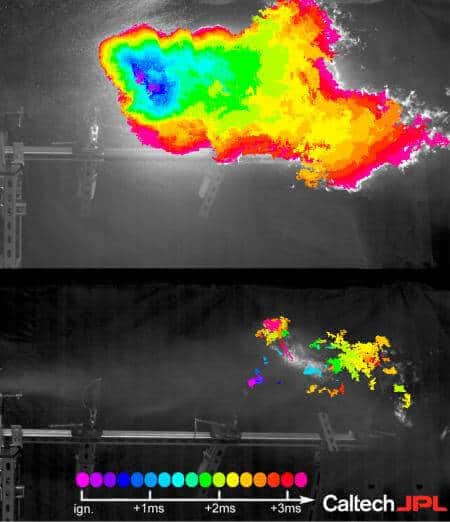Before embarking on a transcontinental journey, jet airplanes fill up with tens of thousands of gallons of fuel. In the event of a crash, such large quantities of fuel increase the severity of an explosion upon impact. Researchers at Caltech and JPL have discovered a polymeric fuel additive that can reduce the intensity of postimpact explosions that occur during accidents and terrorist acts. Furthermore, preliminary results show that the additive can provide this benefit without adversely affecting fuel performance.
The work is published in the October 2 issue of the journal Science.
Jet engines compress air and combine it with a fine spray of jet fuel. Ignition of the mixture of air and jet fuel by an electric spark triggers a controlled explosion that thrusts the plane forward. Jet airplanes are powered by thousands of these tiny explosions. However, the process that distributes the spray of fuel for ignition—known as misting—also causes fuel to rapidly disperse and easily catch fire in the event of an impact.
The additive, created in the laboratory of Julia Kornfield (BS ’83), professor of chemical engineering, is a type of polymer—a long molecule made up of many repeating subunits—capped at each end by units that act like Velcro. The individual polymers spontaneously link into ultralong chains called “megasupramolecules.”
Megasupramolecules, Kornfield says, have an unprecedented combination of properties that allows them to control fuel misting, improve the flow of fuel through pipelines, and reduce soot formation. Megasupramolecules inhibit misting under crash conditions and permit misting during fuel injection in the engine.
Other polymers have shown these benefits, but have deficiencies that limit their usefulness. For example, ultralong polymers tend to break irreversibly when passing through pumps, pipelines, and filters. As a result, they lose their useful properties. This is not an issue with megasupramolecules, however. Although supramolecules also detach into smaller parts as they pass through a pump, the process is reversible. The Velcro-like units at the ends of the individual chains simply reconnect when they meet, effectively “healing” the megasupramolecules.


Well last time something like this was tested, flying a 737 into a specially prepared crash site, it made NO DIFFERENCE whatsoever. So until the same real-life test is done, no one will know if it actually helps at all. The lab is not enough to prove it works.